Analysis of Issues: Sexual Penetration Without Consent (LAWS4102)
VerifiedAdded on 2023/01/19
|12
|3181
|60
Essay
AI Summary
This essay delves into the legal intricacies of sexual penetration without consent, focusing on issues arising from Section 325 of the Western Australian Criminal Code. It examines the definition of consent, exploring the age of consent and the concept of capacity to consent, including intellectual disabilities, intoxication, and mental disorders. The essay critically evaluates how these factors influence the ability to give informed consent. It also addresses intimidation as a factor that can invalidate consent. The analysis extends beyond WA law, drawing on insights from other Australian jurisdictions to provide a comprehensive understanding of the subject. The essay highlights the importance of understanding the legal framework around consent in sexual offenses and the impact of these laws on both victims and the legal system.
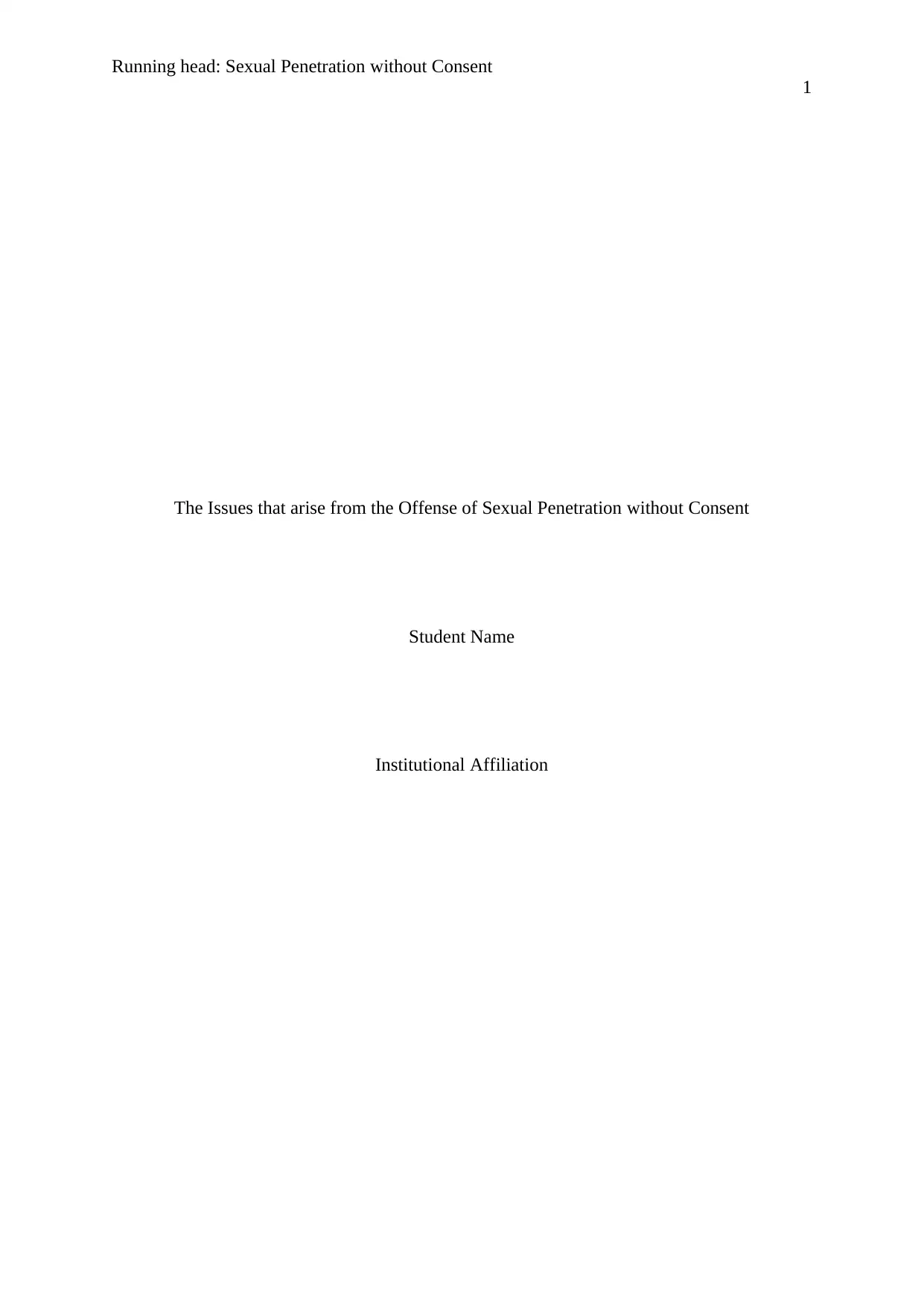
Running head: Sexual Penetration without Consent
1
The Issues that arise from the Offense of Sexual Penetration without Consent
Student Name
Institutional Affiliation
1
The Issues that arise from the Offense of Sexual Penetration without Consent
Student Name
Institutional Affiliation
Paraphrase This Document
Need a fresh take? Get an instant paraphrase of this document with our AI Paraphraser
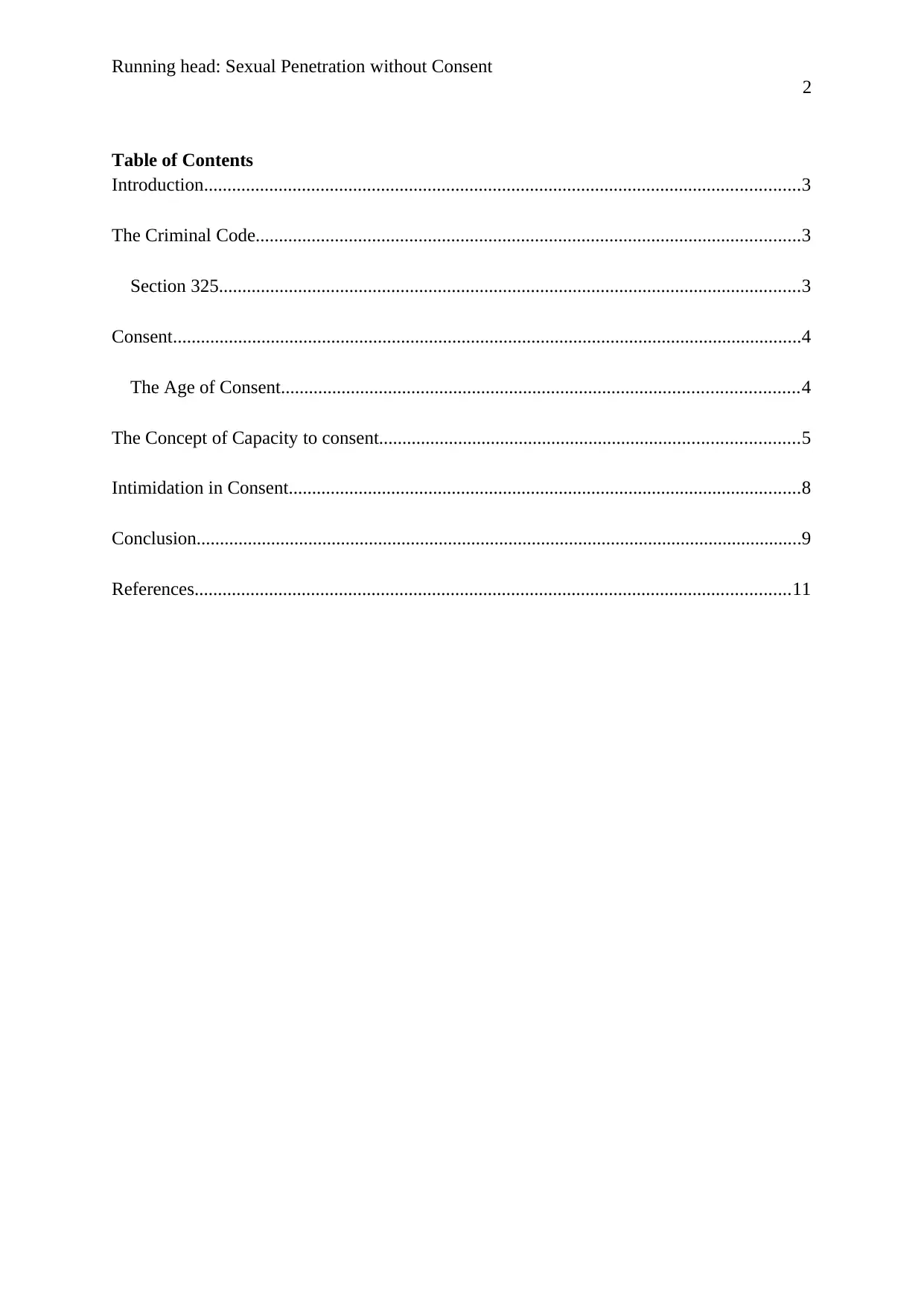
Running head: Sexual Penetration without Consent
2
Table of Contents
Introduction................................................................................................................................3
The Criminal Code.....................................................................................................................3
Section 325.............................................................................................................................3
Consent.......................................................................................................................................4
The Age of Consent...............................................................................................................4
The Concept of Capacity to consent..........................................................................................5
Intimidation in Consent..............................................................................................................8
Conclusion..................................................................................................................................9
References................................................................................................................................11
2
Table of Contents
Introduction................................................................................................................................3
The Criminal Code.....................................................................................................................3
Section 325.............................................................................................................................3
Consent.......................................................................................................................................4
The Age of Consent...............................................................................................................4
The Concept of Capacity to consent..........................................................................................5
Intimidation in Consent..............................................................................................................8
Conclusion..................................................................................................................................9
References................................................................................................................................11
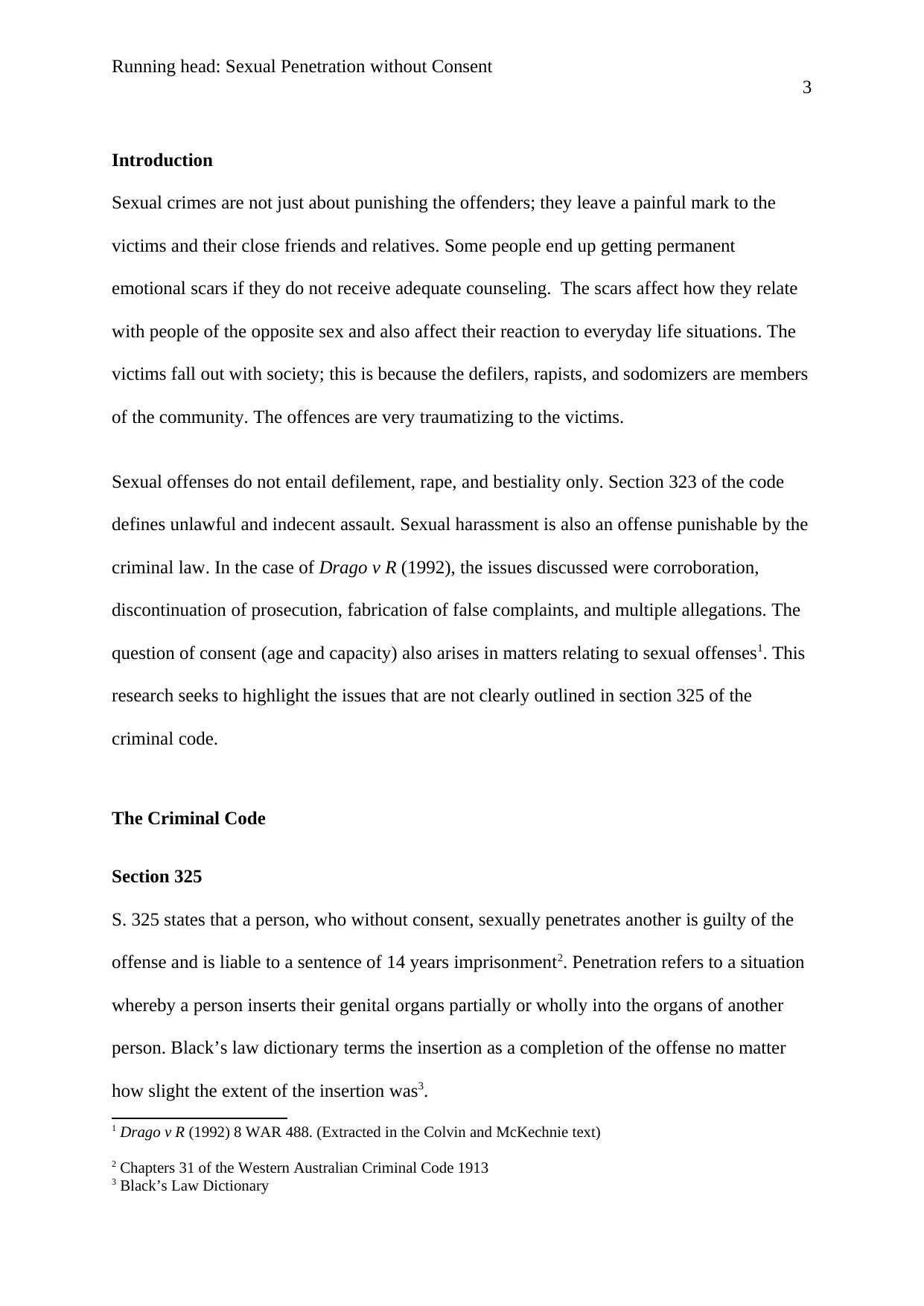
Running head: Sexual Penetration without Consent
3
Introduction
Sexual crimes are not just about punishing the offenders; they leave a painful mark to the
victims and their close friends and relatives. Some people end up getting permanent
emotional scars if they do not receive adequate counseling. The scars affect how they relate
with people of the opposite sex and also affect their reaction to everyday life situations. The
victims fall out with society; this is because the defilers, rapists, and sodomizers are members
of the community. The offences are very traumatizing to the victims.
Sexual offenses do not entail defilement, rape, and bestiality only. Section 323 of the code
defines unlawful and indecent assault. Sexual harassment is also an offense punishable by the
criminal law. In the case of Drago v R (1992), the issues discussed were corroboration,
discontinuation of prosecution, fabrication of false complaints, and multiple allegations. The
question of consent (age and capacity) also arises in matters relating to sexual offenses1. This
research seeks to highlight the issues that are not clearly outlined in section 325 of the
criminal code.
The Criminal Code
Section 325
S. 325 states that a person, who without consent, sexually penetrates another is guilty of the
offense and is liable to a sentence of 14 years imprisonment2. Penetration refers to a situation
whereby a person inserts their genital organs partially or wholly into the organs of another
person. Black’s law dictionary terms the insertion as a completion of the offense no matter
how slight the extent of the insertion was3.
1 Drago v R (1992) 8 WAR 488. (Extracted in the Colvin and McKechnie text)
2 Chapters 31 of the Western Australian Criminal Code 1913
3 Black’s Law Dictionary
3
Introduction
Sexual crimes are not just about punishing the offenders; they leave a painful mark to the
victims and their close friends and relatives. Some people end up getting permanent
emotional scars if they do not receive adequate counseling. The scars affect how they relate
with people of the opposite sex and also affect their reaction to everyday life situations. The
victims fall out with society; this is because the defilers, rapists, and sodomizers are members
of the community. The offences are very traumatizing to the victims.
Sexual offenses do not entail defilement, rape, and bestiality only. Section 323 of the code
defines unlawful and indecent assault. Sexual harassment is also an offense punishable by the
criminal law. In the case of Drago v R (1992), the issues discussed were corroboration,
discontinuation of prosecution, fabrication of false complaints, and multiple allegations. The
question of consent (age and capacity) also arises in matters relating to sexual offenses1. This
research seeks to highlight the issues that are not clearly outlined in section 325 of the
criminal code.
The Criminal Code
Section 325
S. 325 states that a person, who without consent, sexually penetrates another is guilty of the
offense and is liable to a sentence of 14 years imprisonment2. Penetration refers to a situation
whereby a person inserts their genital organs partially or wholly into the organs of another
person. Black’s law dictionary terms the insertion as a completion of the offense no matter
how slight the extent of the insertion was3.
1 Drago v R (1992) 8 WAR 488. (Extracted in the Colvin and McKechnie text)
2 Chapters 31 of the Western Australian Criminal Code 1913
3 Black’s Law Dictionary
⊘ This is a preview!⊘
Do you want full access?
Subscribe today to unlock all pages.

Trusted by 1+ million students worldwide
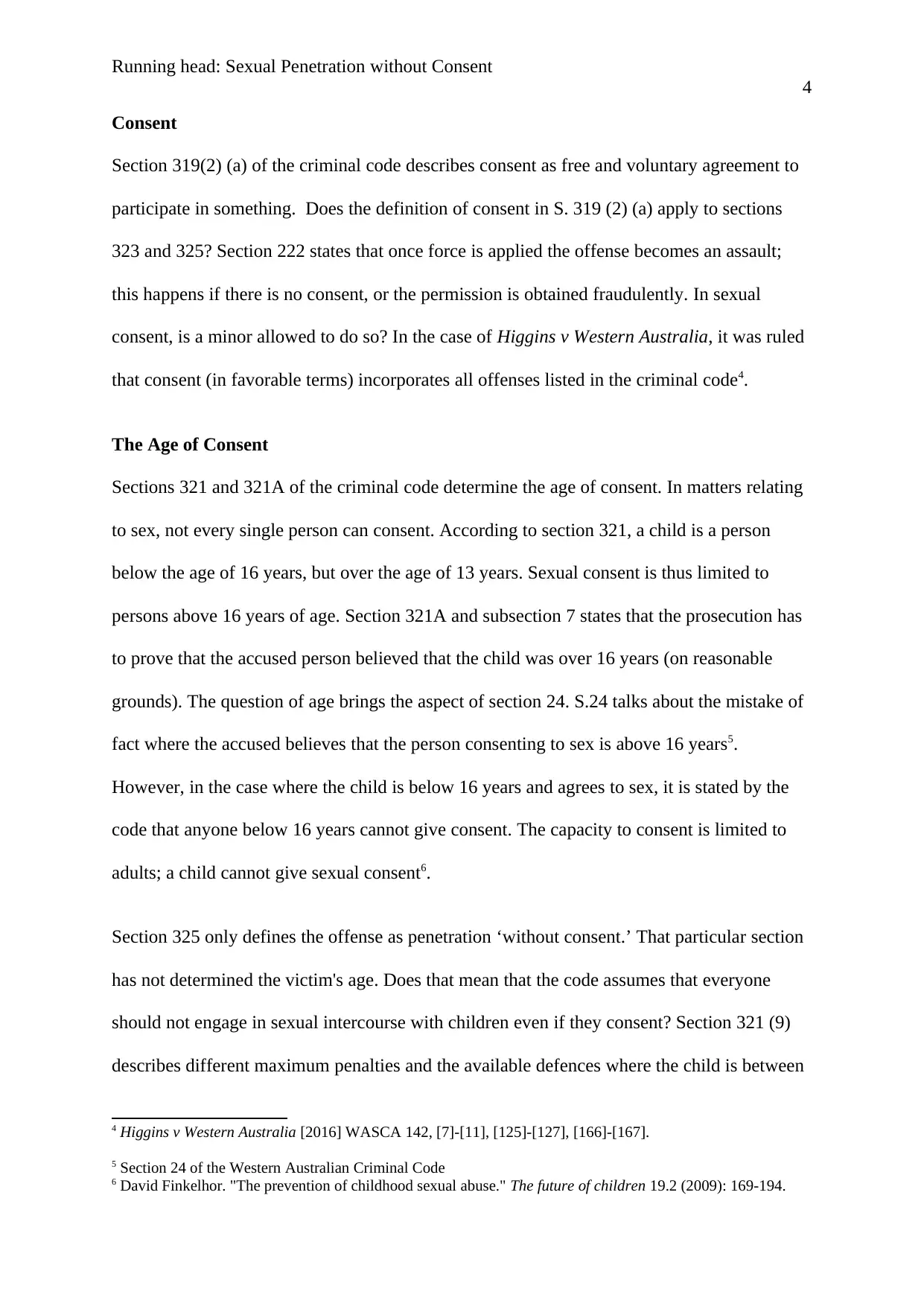
Running head: Sexual Penetration without Consent
4
Consent
Section 319(2) (a) of the criminal code describes consent as free and voluntary agreement to
participate in something. Does the definition of consent in S. 319 (2) (a) apply to sections
323 and 325? Section 222 states that once force is applied the offense becomes an assault;
this happens if there is no consent, or the permission is obtained fraudulently. In sexual
consent, is a minor allowed to do so? In the case of Higgins v Western Australia, it was ruled
that consent (in favorable terms) incorporates all offenses listed in the criminal code4.
The Age of Consent
Sections 321 and 321A of the criminal code determine the age of consent. In matters relating
to sex, not every single person can consent. According to section 321, a child is a person
below the age of 16 years, but over the age of 13 years. Sexual consent is thus limited to
persons above 16 years of age. Section 321A and subsection 7 states that the prosecution has
to prove that the accused person believed that the child was over 16 years (on reasonable
grounds). The question of age brings the aspect of section 24. S.24 talks about the mistake of
fact where the accused believes that the person consenting to sex is above 16 years5.
However, in the case where the child is below 16 years and agrees to sex, it is stated by the
code that anyone below 16 years cannot give consent. The capacity to consent is limited to
adults; a child cannot give sexual consent6.
Section 325 only defines the offense as penetration ‘without consent.’ That particular section
has not determined the victim's age. Does that mean that the code assumes that everyone
should not engage in sexual intercourse with children even if they consent? Section 321 (9)
describes different maximum penalties and the available defences where the child is between
4 Higgins v Western Australia [2016] WASCA 142, [7]-[11], [125]-[127], [166]-[167].
5 Section 24 of the Western Australian Criminal Code
6 David Finkelhor. "The prevention of childhood sexual abuse." The future of children 19.2 (2009): 169-194.
4
Consent
Section 319(2) (a) of the criminal code describes consent as free and voluntary agreement to
participate in something. Does the definition of consent in S. 319 (2) (a) apply to sections
323 and 325? Section 222 states that once force is applied the offense becomes an assault;
this happens if there is no consent, or the permission is obtained fraudulently. In sexual
consent, is a minor allowed to do so? In the case of Higgins v Western Australia, it was ruled
that consent (in favorable terms) incorporates all offenses listed in the criminal code4.
The Age of Consent
Sections 321 and 321A of the criminal code determine the age of consent. In matters relating
to sex, not every single person can consent. According to section 321, a child is a person
below the age of 16 years, but over the age of 13 years. Sexual consent is thus limited to
persons above 16 years of age. Section 321A and subsection 7 states that the prosecution has
to prove that the accused person believed that the child was over 16 years (on reasonable
grounds). The question of age brings the aspect of section 24. S.24 talks about the mistake of
fact where the accused believes that the person consenting to sex is above 16 years5.
However, in the case where the child is below 16 years and agrees to sex, it is stated by the
code that anyone below 16 years cannot give consent. The capacity to consent is limited to
adults; a child cannot give sexual consent6.
Section 325 only defines the offense as penetration ‘without consent.’ That particular section
has not determined the victim's age. Does that mean that the code assumes that everyone
should not engage in sexual intercourse with children even if they consent? Section 321 (9)
describes different maximum penalties and the available defences where the child is between
4 Higgins v Western Australia [2016] WASCA 142, [7]-[11], [125]-[127], [166]-[167].
5 Section 24 of the Western Australian Criminal Code
6 David Finkelhor. "The prevention of childhood sexual abuse." The future of children 19.2 (2009): 169-194.
Paraphrase This Document
Need a fresh take? Get an instant paraphrase of this document with our AI Paraphraser
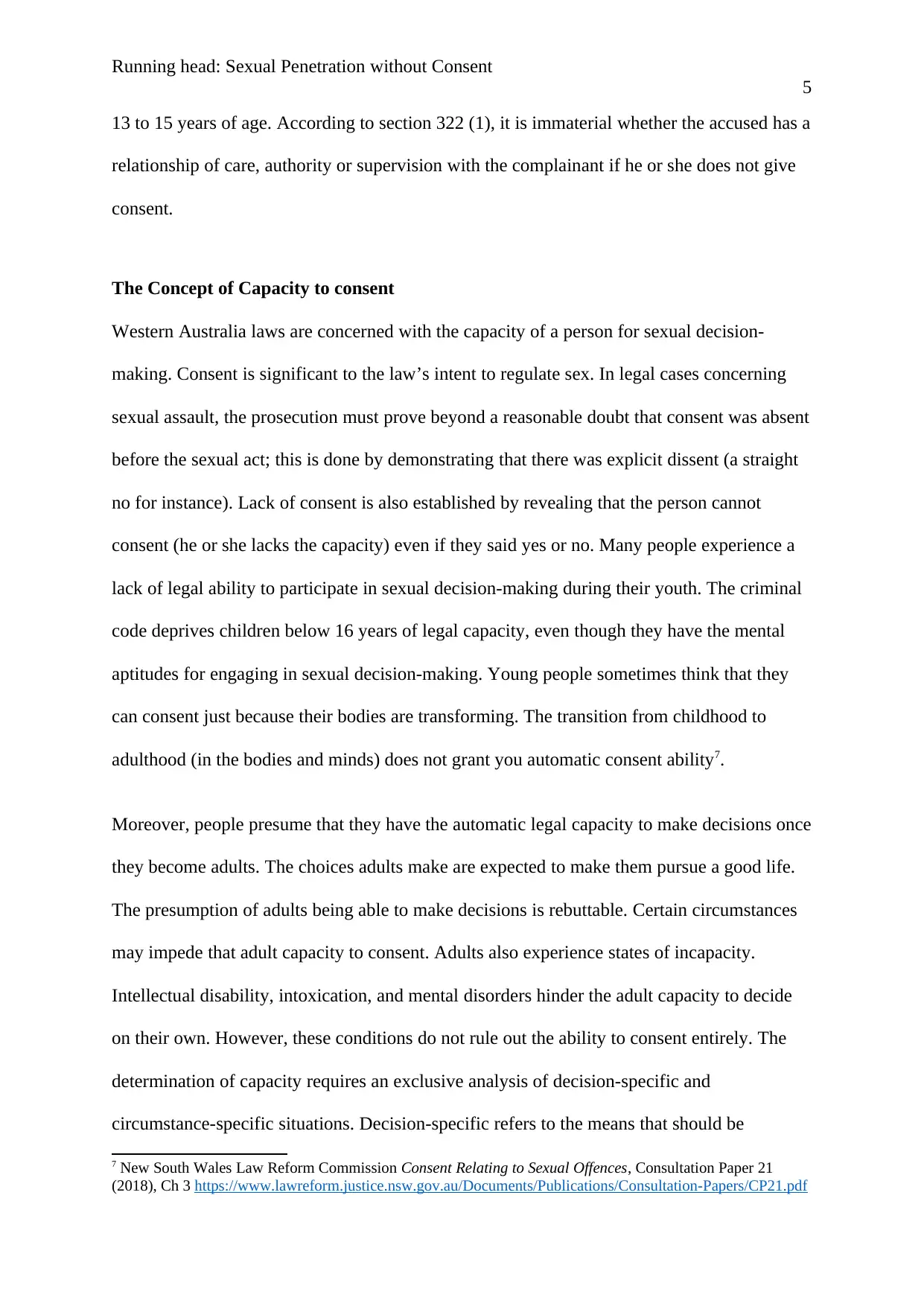
Running head: Sexual Penetration without Consent
5
13 to 15 years of age. According to section 322 (1), it is immaterial whether the accused has a
relationship of care, authority or supervision with the complainant if he or she does not give
consent.
The Concept of Capacity to consent
Western Australia laws are concerned with the capacity of a person for sexual decision-
making. Consent is significant to the law’s intent to regulate sex. In legal cases concerning
sexual assault, the prosecution must prove beyond a reasonable doubt that consent was absent
before the sexual act; this is done by demonstrating that there was explicit dissent (a straight
no for instance). Lack of consent is also established by revealing that the person cannot
consent (he or she lacks the capacity) even if they said yes or no. Many people experience a
lack of legal ability to participate in sexual decision-making during their youth. The criminal
code deprives children below 16 years of legal capacity, even though they have the mental
aptitudes for engaging in sexual decision-making. Young people sometimes think that they
can consent just because their bodies are transforming. The transition from childhood to
adulthood (in the bodies and minds) does not grant you automatic consent ability7.
Moreover, people presume that they have the automatic legal capacity to make decisions once
they become adults. The choices adults make are expected to make them pursue a good life.
The presumption of adults being able to make decisions is rebuttable. Certain circumstances
may impede that adult capacity to consent. Adults also experience states of incapacity.
Intellectual disability, intoxication, and mental disorders hinder the adult capacity to decide
on their own. However, these conditions do not rule out the ability to consent entirely. The
determination of capacity requires an exclusive analysis of decision-specific and
circumstance-specific situations. Decision-specific refers to the means that should be
7 New South Wales Law Reform Commission Consent Relating to Sexual Offences, Consultation Paper 21
(2018), Ch 3 https://www.lawreform.justice.nsw.gov.au/Documents/Publications/Consultation-Papers/CP21.pdf
5
13 to 15 years of age. According to section 322 (1), it is immaterial whether the accused has a
relationship of care, authority or supervision with the complainant if he or she does not give
consent.
The Concept of Capacity to consent
Western Australia laws are concerned with the capacity of a person for sexual decision-
making. Consent is significant to the law’s intent to regulate sex. In legal cases concerning
sexual assault, the prosecution must prove beyond a reasonable doubt that consent was absent
before the sexual act; this is done by demonstrating that there was explicit dissent (a straight
no for instance). Lack of consent is also established by revealing that the person cannot
consent (he or she lacks the capacity) even if they said yes or no. Many people experience a
lack of legal ability to participate in sexual decision-making during their youth. The criminal
code deprives children below 16 years of legal capacity, even though they have the mental
aptitudes for engaging in sexual decision-making. Young people sometimes think that they
can consent just because their bodies are transforming. The transition from childhood to
adulthood (in the bodies and minds) does not grant you automatic consent ability7.
Moreover, people presume that they have the automatic legal capacity to make decisions once
they become adults. The choices adults make are expected to make them pursue a good life.
The presumption of adults being able to make decisions is rebuttable. Certain circumstances
may impede that adult capacity to consent. Adults also experience states of incapacity.
Intellectual disability, intoxication, and mental disorders hinder the adult capacity to decide
on their own. However, these conditions do not rule out the ability to consent entirely. The
determination of capacity requires an exclusive analysis of decision-specific and
circumstance-specific situations. Decision-specific refers to the means that should be
7 New South Wales Law Reform Commission Consent Relating to Sexual Offences, Consultation Paper 21
(2018), Ch 3 https://www.lawreform.justice.nsw.gov.au/Documents/Publications/Consultation-Papers/CP21.pdf
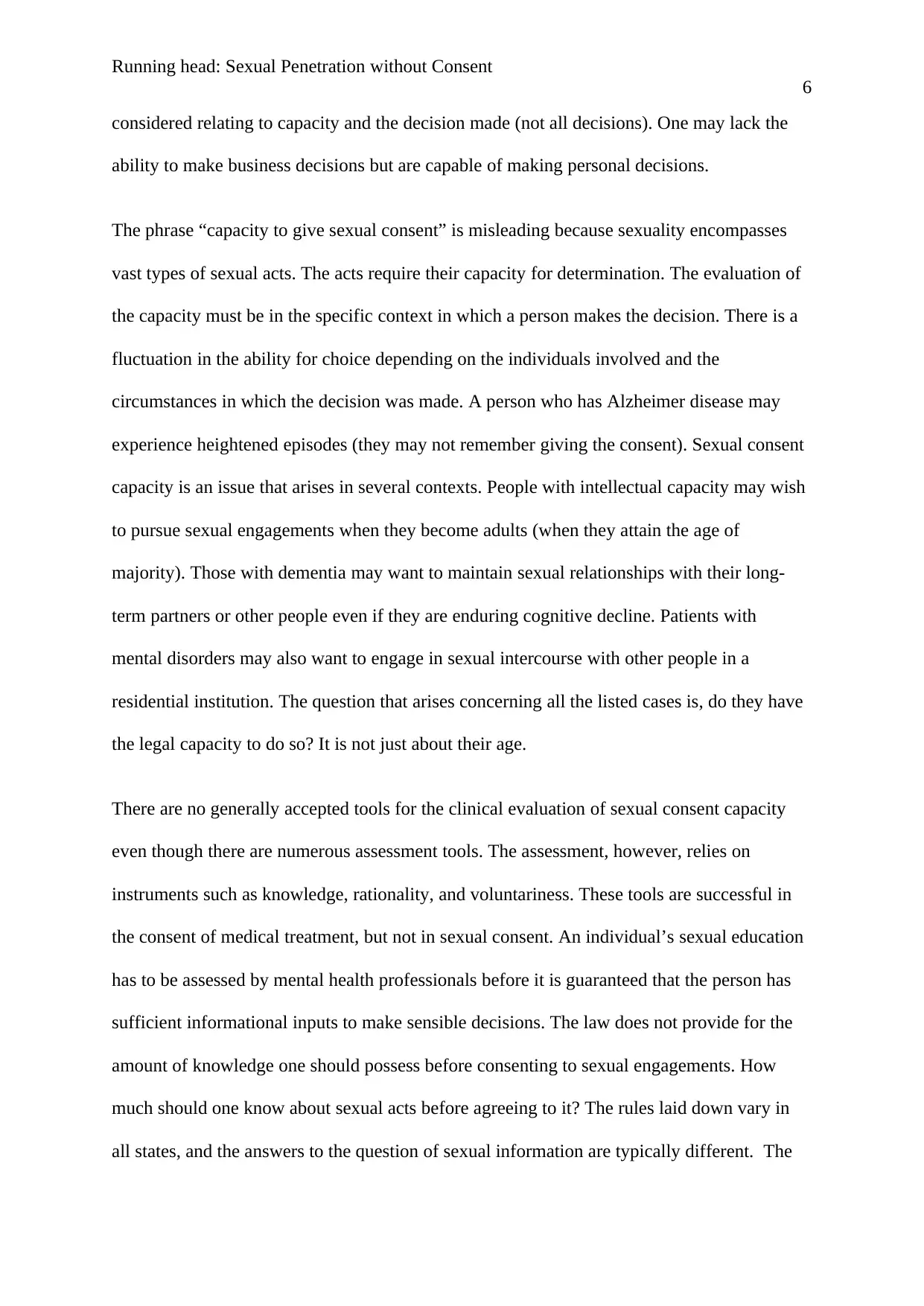
Running head: Sexual Penetration without Consent
6
considered relating to capacity and the decision made (not all decisions). One may lack the
ability to make business decisions but are capable of making personal decisions.
The phrase “capacity to give sexual consent” is misleading because sexuality encompasses
vast types of sexual acts. The acts require their capacity for determination. The evaluation of
the capacity must be in the specific context in which a person makes the decision. There is a
fluctuation in the ability for choice depending on the individuals involved and the
circumstances in which the decision was made. A person who has Alzheimer disease may
experience heightened episodes (they may not remember giving the consent). Sexual consent
capacity is an issue that arises in several contexts. People with intellectual capacity may wish
to pursue sexual engagements when they become adults (when they attain the age of
majority). Those with dementia may want to maintain sexual relationships with their long-
term partners or other people even if they are enduring cognitive decline. Patients with
mental disorders may also want to engage in sexual intercourse with other people in a
residential institution. The question that arises concerning all the listed cases is, do they have
the legal capacity to do so? It is not just about their age.
There are no generally accepted tools for the clinical evaluation of sexual consent capacity
even though there are numerous assessment tools. The assessment, however, relies on
instruments such as knowledge, rationality, and voluntariness. These tools are successful in
the consent of medical treatment, but not in sexual consent. An individual’s sexual education
has to be assessed by mental health professionals before it is guaranteed that the person has
sufficient informational inputs to make sensible decisions. The law does not provide for the
amount of knowledge one should possess before consenting to sexual engagements. How
much should one know about sexual acts before agreeing to it? The rules laid down vary in
all states, and the answers to the question of sexual information are typically different. The
6
considered relating to capacity and the decision made (not all decisions). One may lack the
ability to make business decisions but are capable of making personal decisions.
The phrase “capacity to give sexual consent” is misleading because sexuality encompasses
vast types of sexual acts. The acts require their capacity for determination. The evaluation of
the capacity must be in the specific context in which a person makes the decision. There is a
fluctuation in the ability for choice depending on the individuals involved and the
circumstances in which the decision was made. A person who has Alzheimer disease may
experience heightened episodes (they may not remember giving the consent). Sexual consent
capacity is an issue that arises in several contexts. People with intellectual capacity may wish
to pursue sexual engagements when they become adults (when they attain the age of
majority). Those with dementia may want to maintain sexual relationships with their long-
term partners or other people even if they are enduring cognitive decline. Patients with
mental disorders may also want to engage in sexual intercourse with other people in a
residential institution. The question that arises concerning all the listed cases is, do they have
the legal capacity to do so? It is not just about their age.
There are no generally accepted tools for the clinical evaluation of sexual consent capacity
even though there are numerous assessment tools. The assessment, however, relies on
instruments such as knowledge, rationality, and voluntariness. These tools are successful in
the consent of medical treatment, but not in sexual consent. An individual’s sexual education
has to be assessed by mental health professionals before it is guaranteed that the person has
sufficient informational inputs to make sensible decisions. The law does not provide for the
amount of knowledge one should possess before consenting to sexual engagements. How
much should one know about sexual acts before agreeing to it? The rules laid down vary in
all states, and the answers to the question of sexual information are typically different. The
⊘ This is a preview!⊘
Do you want full access?
Subscribe today to unlock all pages.

Trusted by 1+ million students worldwide
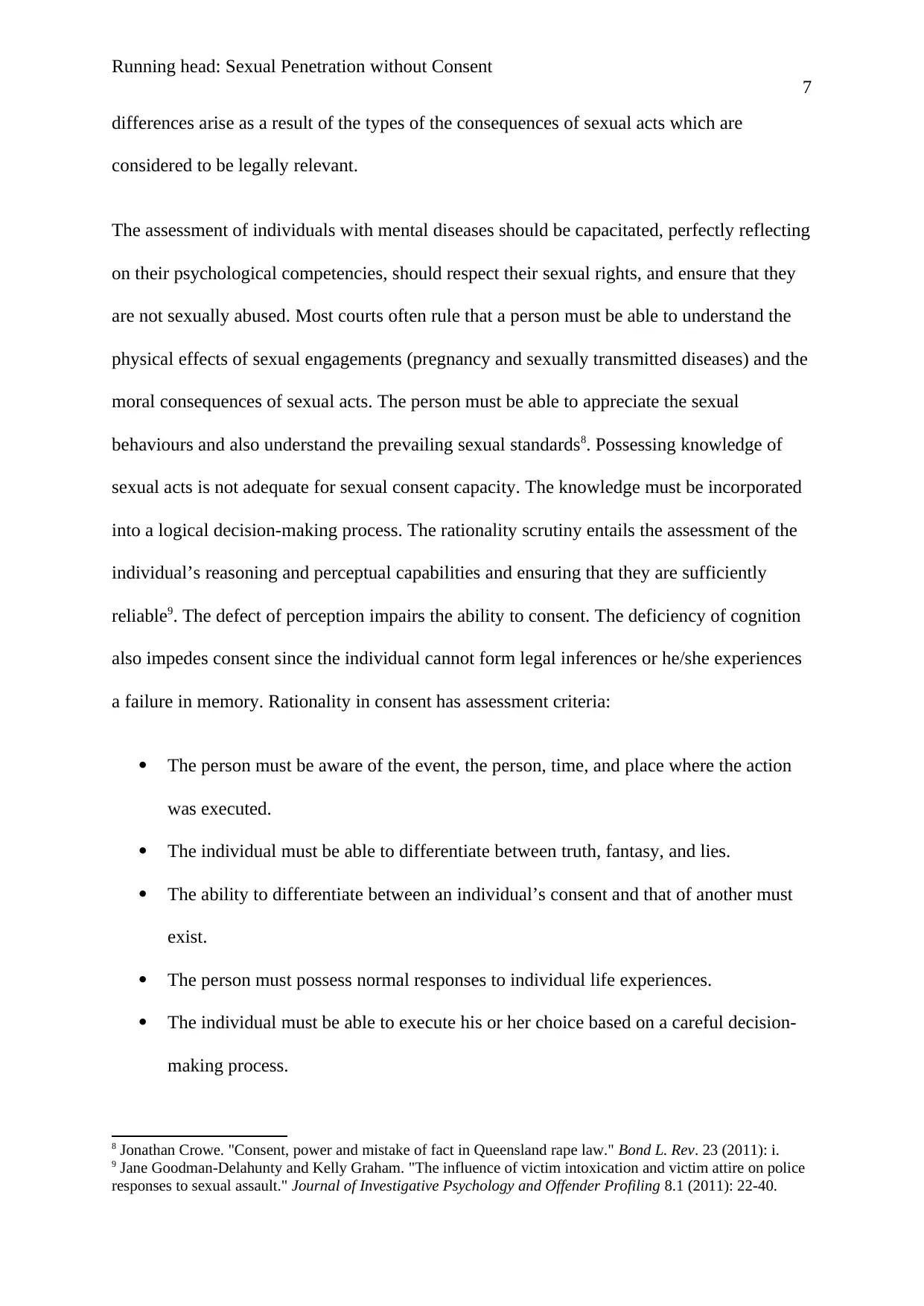
Running head: Sexual Penetration without Consent
7
differences arise as a result of the types of the consequences of sexual acts which are
considered to be legally relevant.
The assessment of individuals with mental diseases should be capacitated, perfectly reflecting
on their psychological competencies, should respect their sexual rights, and ensure that they
are not sexually abused. Most courts often rule that a person must be able to understand the
physical effects of sexual engagements (pregnancy and sexually transmitted diseases) and the
moral consequences of sexual acts. The person must be able to appreciate the sexual
behaviours and also understand the prevailing sexual standards8. Possessing knowledge of
sexual acts is not adequate for sexual consent capacity. The knowledge must be incorporated
into a logical decision-making process. The rationality scrutiny entails the assessment of the
individual’s reasoning and perceptual capabilities and ensuring that they are sufficiently
reliable9. The defect of perception impairs the ability to consent. The deficiency of cognition
also impedes consent since the individual cannot form legal inferences or he/she experiences
a failure in memory. Rationality in consent has assessment criteria:
The person must be aware of the event, the person, time, and place where the action
was executed.
The individual must be able to differentiate between truth, fantasy, and lies.
The ability to differentiate between an individual’s consent and that of another must
exist.
The person must possess normal responses to individual life experiences.
The individual must be able to execute his or her choice based on a careful decision-
making process.
8 Jonathan Crowe. "Consent, power and mistake of fact in Queensland rape law." Bond L. Rev. 23 (2011): i.
9 Jane Goodman‐Delahunty and Kelly Graham. "The influence of victim intoxication and victim attire on police
responses to sexual assault." Journal of Investigative Psychology and Offender Profiling 8.1 (2011): 22-40.
7
differences arise as a result of the types of the consequences of sexual acts which are
considered to be legally relevant.
The assessment of individuals with mental diseases should be capacitated, perfectly reflecting
on their psychological competencies, should respect their sexual rights, and ensure that they
are not sexually abused. Most courts often rule that a person must be able to understand the
physical effects of sexual engagements (pregnancy and sexually transmitted diseases) and the
moral consequences of sexual acts. The person must be able to appreciate the sexual
behaviours and also understand the prevailing sexual standards8. Possessing knowledge of
sexual acts is not adequate for sexual consent capacity. The knowledge must be incorporated
into a logical decision-making process. The rationality scrutiny entails the assessment of the
individual’s reasoning and perceptual capabilities and ensuring that they are sufficiently
reliable9. The defect of perception impairs the ability to consent. The deficiency of cognition
also impedes consent since the individual cannot form legal inferences or he/she experiences
a failure in memory. Rationality in consent has assessment criteria:
The person must be aware of the event, the person, time, and place where the action
was executed.
The individual must be able to differentiate between truth, fantasy, and lies.
The ability to differentiate between an individual’s consent and that of another must
exist.
The person must possess normal responses to individual life experiences.
The individual must be able to execute his or her choice based on a careful decision-
making process.
8 Jonathan Crowe. "Consent, power and mistake of fact in Queensland rape law." Bond L. Rev. 23 (2011): i.
9 Jane Goodman‐Delahunty and Kelly Graham. "The influence of victim intoxication and victim attire on police
responses to sexual assault." Journal of Investigative Psychology and Offender Profiling 8.1 (2011): 22-40.
Paraphrase This Document
Need a fresh take? Get an instant paraphrase of this document with our AI Paraphraser
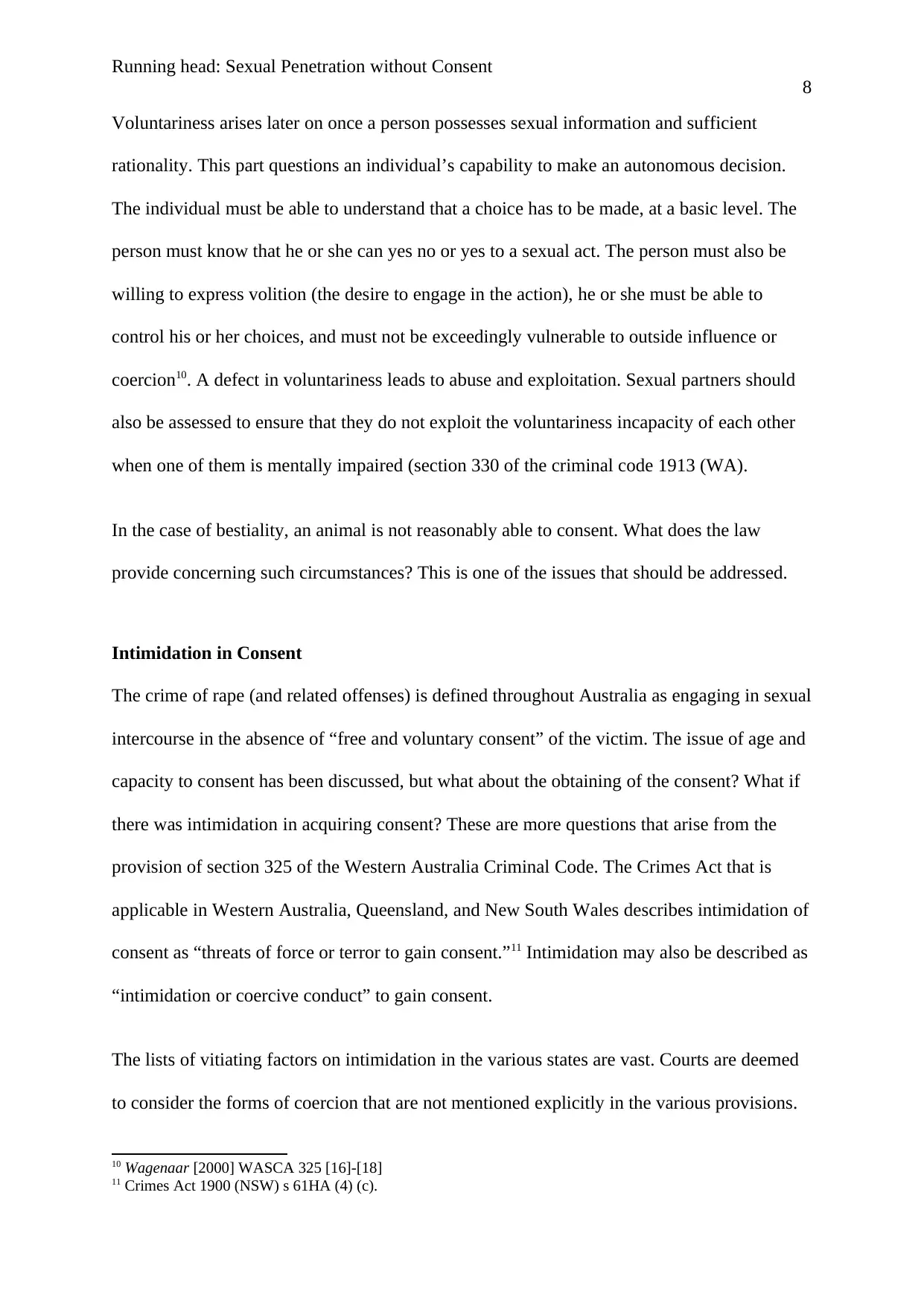
Running head: Sexual Penetration without Consent
8
Voluntariness arises later on once a person possesses sexual information and sufficient
rationality. This part questions an individual’s capability to make an autonomous decision.
The individual must be able to understand that a choice has to be made, at a basic level. The
person must know that he or she can yes no or yes to a sexual act. The person must also be
willing to express volition (the desire to engage in the action), he or she must be able to
control his or her choices, and must not be exceedingly vulnerable to outside influence or
coercion10. A defect in voluntariness leads to abuse and exploitation. Sexual partners should
also be assessed to ensure that they do not exploit the voluntariness incapacity of each other
when one of them is mentally impaired (section 330 of the criminal code 1913 (WA).
In the case of bestiality, an animal is not reasonably able to consent. What does the law
provide concerning such circumstances? This is one of the issues that should be addressed.
Intimidation in Consent
The crime of rape (and related offenses) is defined throughout Australia as engaging in sexual
intercourse in the absence of “free and voluntary consent” of the victim. The issue of age and
capacity to consent has been discussed, but what about the obtaining of the consent? What if
there was intimidation in acquiring consent? These are more questions that arise from the
provision of section 325 of the Western Australia Criminal Code. The Crimes Act that is
applicable in Western Australia, Queensland, and New South Wales describes intimidation of
consent as “threats of force or terror to gain consent.”11 Intimidation may also be described as
“intimidation or coercive conduct” to gain consent.
The lists of vitiating factors on intimidation in the various states are vast. Courts are deemed
to consider the forms of coercion that are not mentioned explicitly in the various provisions.
10 Wagenaar [2000] WASCA 325 [16]-[18]
11 Crimes Act 1900 (NSW) s 61HA (4) (c).
8
Voluntariness arises later on once a person possesses sexual information and sufficient
rationality. This part questions an individual’s capability to make an autonomous decision.
The individual must be able to understand that a choice has to be made, at a basic level. The
person must know that he or she can yes no or yes to a sexual act. The person must also be
willing to express volition (the desire to engage in the action), he or she must be able to
control his or her choices, and must not be exceedingly vulnerable to outside influence or
coercion10. A defect in voluntariness leads to abuse and exploitation. Sexual partners should
also be assessed to ensure that they do not exploit the voluntariness incapacity of each other
when one of them is mentally impaired (section 330 of the criminal code 1913 (WA).
In the case of bestiality, an animal is not reasonably able to consent. What does the law
provide concerning such circumstances? This is one of the issues that should be addressed.
Intimidation in Consent
The crime of rape (and related offenses) is defined throughout Australia as engaging in sexual
intercourse in the absence of “free and voluntary consent” of the victim. The issue of age and
capacity to consent has been discussed, but what about the obtaining of the consent? What if
there was intimidation in acquiring consent? These are more questions that arise from the
provision of section 325 of the Western Australia Criminal Code. The Crimes Act that is
applicable in Western Australia, Queensland, and New South Wales describes intimidation of
consent as “threats of force or terror to gain consent.”11 Intimidation may also be described as
“intimidation or coercive conduct” to gain consent.
The lists of vitiating factors on intimidation in the various states are vast. Courts are deemed
to consider the forms of coercion that are not mentioned explicitly in the various provisions.
10 Wagenaar [2000] WASCA 325 [16]-[18]
11 Crimes Act 1900 (NSW) s 61HA (4) (c).
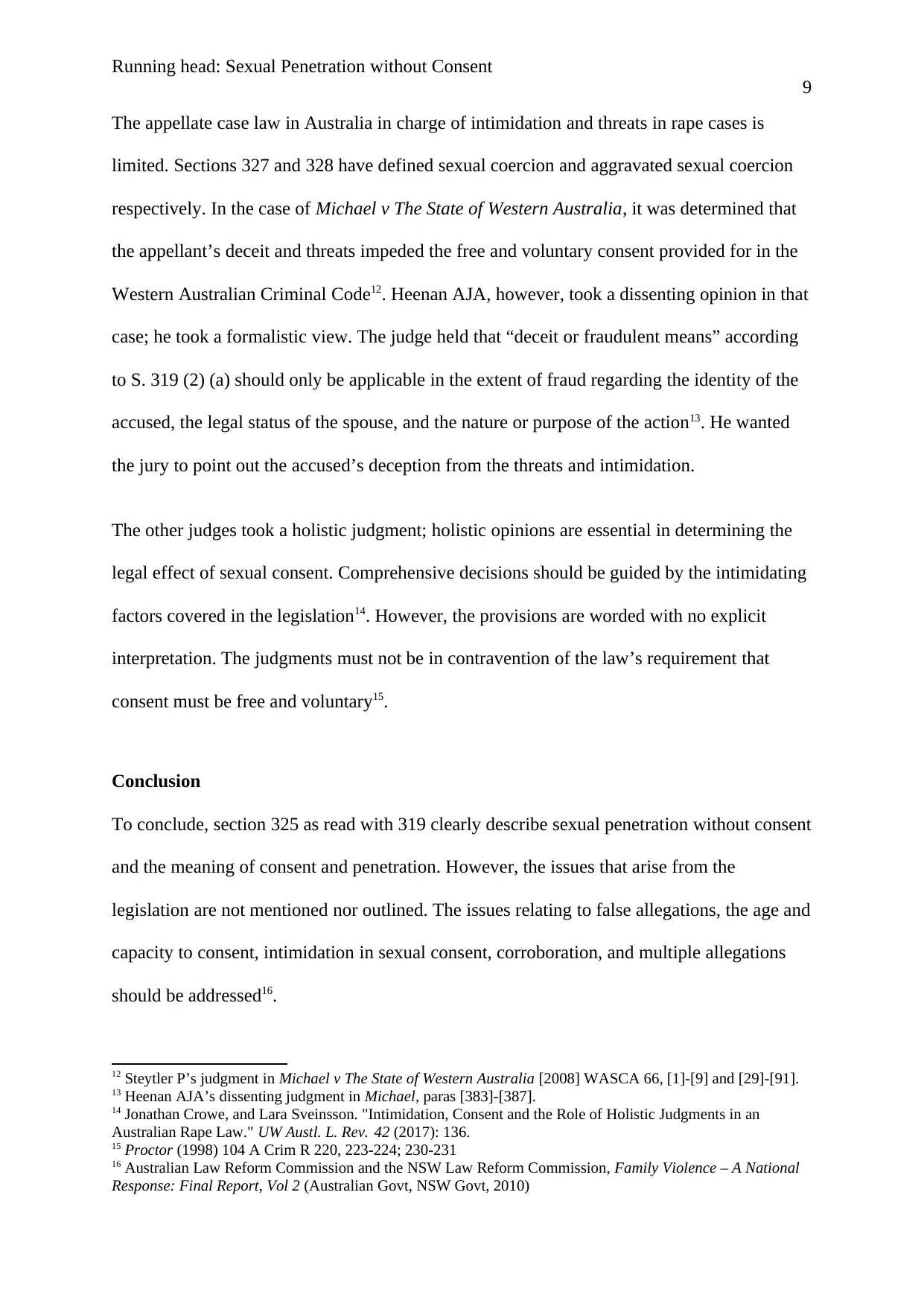
Running head: Sexual Penetration without Consent
9
The appellate case law in Australia in charge of intimidation and threats in rape cases is
limited. Sections 327 and 328 have defined sexual coercion and aggravated sexual coercion
respectively. In the case of Michael v The State of Western Australia, it was determined that
the appellant’s deceit and threats impeded the free and voluntary consent provided for in the
Western Australian Criminal Code12. Heenan AJA, however, took a dissenting opinion in that
case; he took a formalistic view. The judge held that “deceit or fraudulent means” according
to S. 319 (2) (a) should only be applicable in the extent of fraud regarding the identity of the
accused, the legal status of the spouse, and the nature or purpose of the action13. He wanted
the jury to point out the accused’s deception from the threats and intimidation.
The other judges took a holistic judgment; holistic opinions are essential in determining the
legal effect of sexual consent. Comprehensive decisions should be guided by the intimidating
factors covered in the legislation14. However, the provisions are worded with no explicit
interpretation. The judgments must not be in contravention of the law’s requirement that
consent must be free and voluntary15.
Conclusion
To conclude, section 325 as read with 319 clearly describe sexual penetration without consent
and the meaning of consent and penetration. However, the issues that arise from the
legislation are not mentioned nor outlined. The issues relating to false allegations, the age and
capacity to consent, intimidation in sexual consent, corroboration, and multiple allegations
should be addressed16.
12 Steytler P’s judgment in Michael v The State of Western Australia [2008] WASCA 66, [1]-[9] and [29]-[91].
13 Heenan AJA’s dissenting judgment in Michael, paras [383]-[387].
14 Jonathan Crowe, and Lara Sveinsson. "Intimidation, Consent and the Role of Holistic Judgments in an
Australian Rape Law." UW Austl. L. Rev. 42 (2017): 136.
15 Proctor (1998) 104 A Crim R 220, 223-224; 230-231
16 Australian Law Reform Commission and the NSW Law Reform Commission, Family Violence – A National
Response: Final Report, Vol 2 (Australian Govt, NSW Govt, 2010)
9
The appellate case law in Australia in charge of intimidation and threats in rape cases is
limited. Sections 327 and 328 have defined sexual coercion and aggravated sexual coercion
respectively. In the case of Michael v The State of Western Australia, it was determined that
the appellant’s deceit and threats impeded the free and voluntary consent provided for in the
Western Australian Criminal Code12. Heenan AJA, however, took a dissenting opinion in that
case; he took a formalistic view. The judge held that “deceit or fraudulent means” according
to S. 319 (2) (a) should only be applicable in the extent of fraud regarding the identity of the
accused, the legal status of the spouse, and the nature or purpose of the action13. He wanted
the jury to point out the accused’s deception from the threats and intimidation.
The other judges took a holistic judgment; holistic opinions are essential in determining the
legal effect of sexual consent. Comprehensive decisions should be guided by the intimidating
factors covered in the legislation14. However, the provisions are worded with no explicit
interpretation. The judgments must not be in contravention of the law’s requirement that
consent must be free and voluntary15.
Conclusion
To conclude, section 325 as read with 319 clearly describe sexual penetration without consent
and the meaning of consent and penetration. However, the issues that arise from the
legislation are not mentioned nor outlined. The issues relating to false allegations, the age and
capacity to consent, intimidation in sexual consent, corroboration, and multiple allegations
should be addressed16.
12 Steytler P’s judgment in Michael v The State of Western Australia [2008] WASCA 66, [1]-[9] and [29]-[91].
13 Heenan AJA’s dissenting judgment in Michael, paras [383]-[387].
14 Jonathan Crowe, and Lara Sveinsson. "Intimidation, Consent and the Role of Holistic Judgments in an
Australian Rape Law." UW Austl. L. Rev. 42 (2017): 136.
15 Proctor (1998) 104 A Crim R 220, 223-224; 230-231
16 Australian Law Reform Commission and the NSW Law Reform Commission, Family Violence – A National
Response: Final Report, Vol 2 (Australian Govt, NSW Govt, 2010)
⊘ This is a preview!⊘
Do you want full access?
Subscribe today to unlock all pages.

Trusted by 1+ million students worldwide

Running head: Sexual Penetration without Consent
10
10
Paraphrase This Document
Need a fresh take? Get an instant paraphrase of this document with our AI Paraphraser
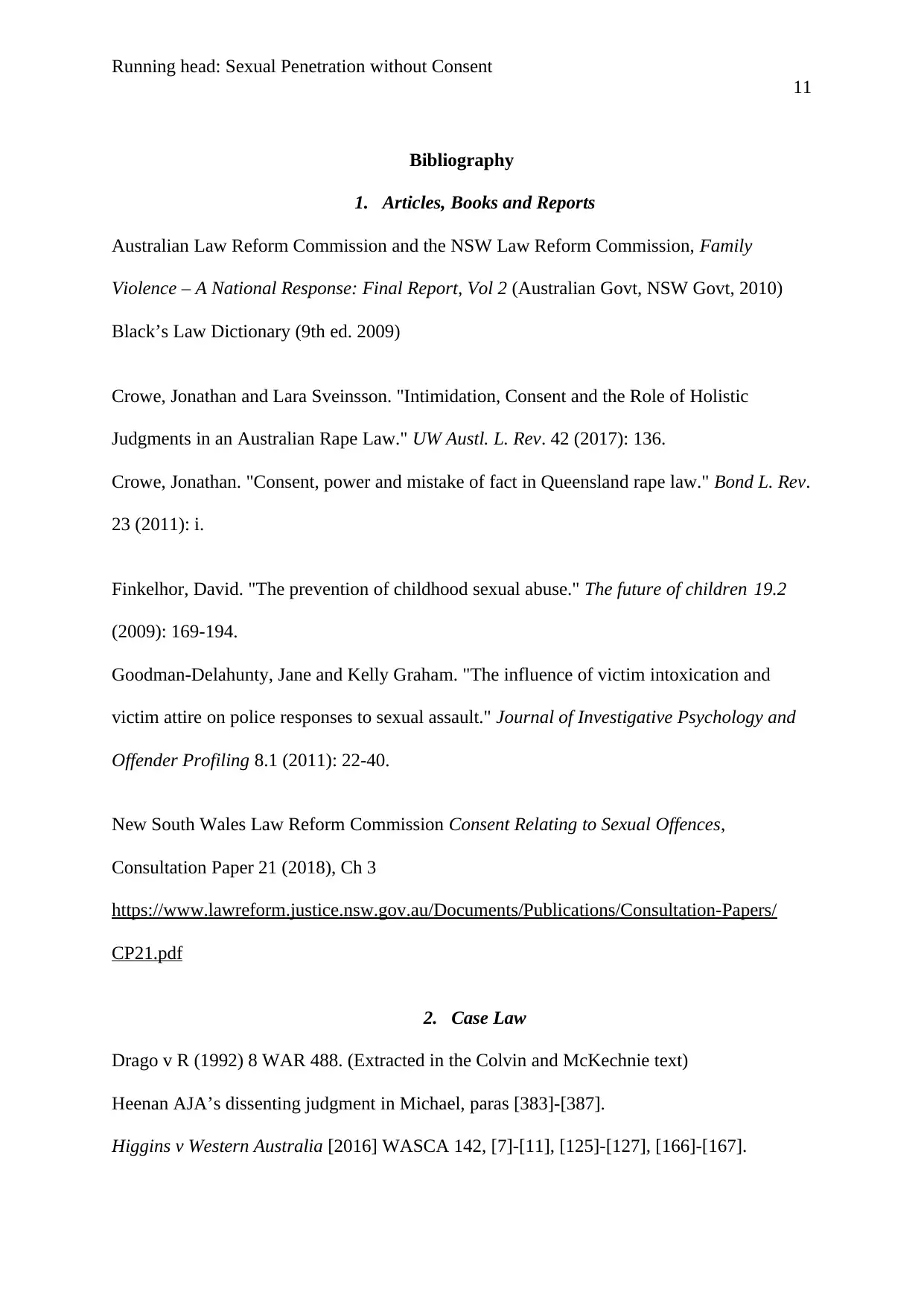
Running head: Sexual Penetration without Consent
11
Bibliography
1. Articles, Books and Reports
Australian Law Reform Commission and the NSW Law Reform Commission, Family
Violence – A National Response: Final Report, Vol 2 (Australian Govt, NSW Govt, 2010)
Black’s Law Dictionary (9th ed. 2009)
Crowe, Jonathan and Lara Sveinsson. "Intimidation, Consent and the Role of Holistic
Judgments in an Australian Rape Law." UW Austl. L. Rev. 42 (2017): 136.
Crowe, Jonathan. "Consent, power and mistake of fact in Queensland rape law." Bond L. Rev.
23 (2011): i.
Finkelhor, David. "The prevention of childhood sexual abuse." The future of children 19.2
(2009): 169-194.
Goodman‐Delahunty, Jane and Kelly Graham. "The influence of victim intoxication and
victim attire on police responses to sexual assault." Journal of Investigative Psychology and
Offender Profiling 8.1 (2011): 22-40.
New South Wales Law Reform Commission Consent Relating to Sexual Offences,
Consultation Paper 21 (2018), Ch 3
https://www.lawreform.justice.nsw.gov.au/Documents/Publications/Consultation-Papers/
CP21.pdf
2. Case Law
Drago v R (1992) 8 WAR 488. (Extracted in the Colvin and McKechnie text)
Heenan AJA’s dissenting judgment in Michael, paras [383]-[387].
Higgins v Western Australia [2016] WASCA 142, [7]-[11], [125]-[127], [166]-[167].
11
Bibliography
1. Articles, Books and Reports
Australian Law Reform Commission and the NSW Law Reform Commission, Family
Violence – A National Response: Final Report, Vol 2 (Australian Govt, NSW Govt, 2010)
Black’s Law Dictionary (9th ed. 2009)
Crowe, Jonathan and Lara Sveinsson. "Intimidation, Consent and the Role of Holistic
Judgments in an Australian Rape Law." UW Austl. L. Rev. 42 (2017): 136.
Crowe, Jonathan. "Consent, power and mistake of fact in Queensland rape law." Bond L. Rev.
23 (2011): i.
Finkelhor, David. "The prevention of childhood sexual abuse." The future of children 19.2
(2009): 169-194.
Goodman‐Delahunty, Jane and Kelly Graham. "The influence of victim intoxication and
victim attire on police responses to sexual assault." Journal of Investigative Psychology and
Offender Profiling 8.1 (2011): 22-40.
New South Wales Law Reform Commission Consent Relating to Sexual Offences,
Consultation Paper 21 (2018), Ch 3
https://www.lawreform.justice.nsw.gov.au/Documents/Publications/Consultation-Papers/
CP21.pdf
2. Case Law
Drago v R (1992) 8 WAR 488. (Extracted in the Colvin and McKechnie text)
Heenan AJA’s dissenting judgment in Michael, paras [383]-[387].
Higgins v Western Australia [2016] WASCA 142, [7]-[11], [125]-[127], [166]-[167].
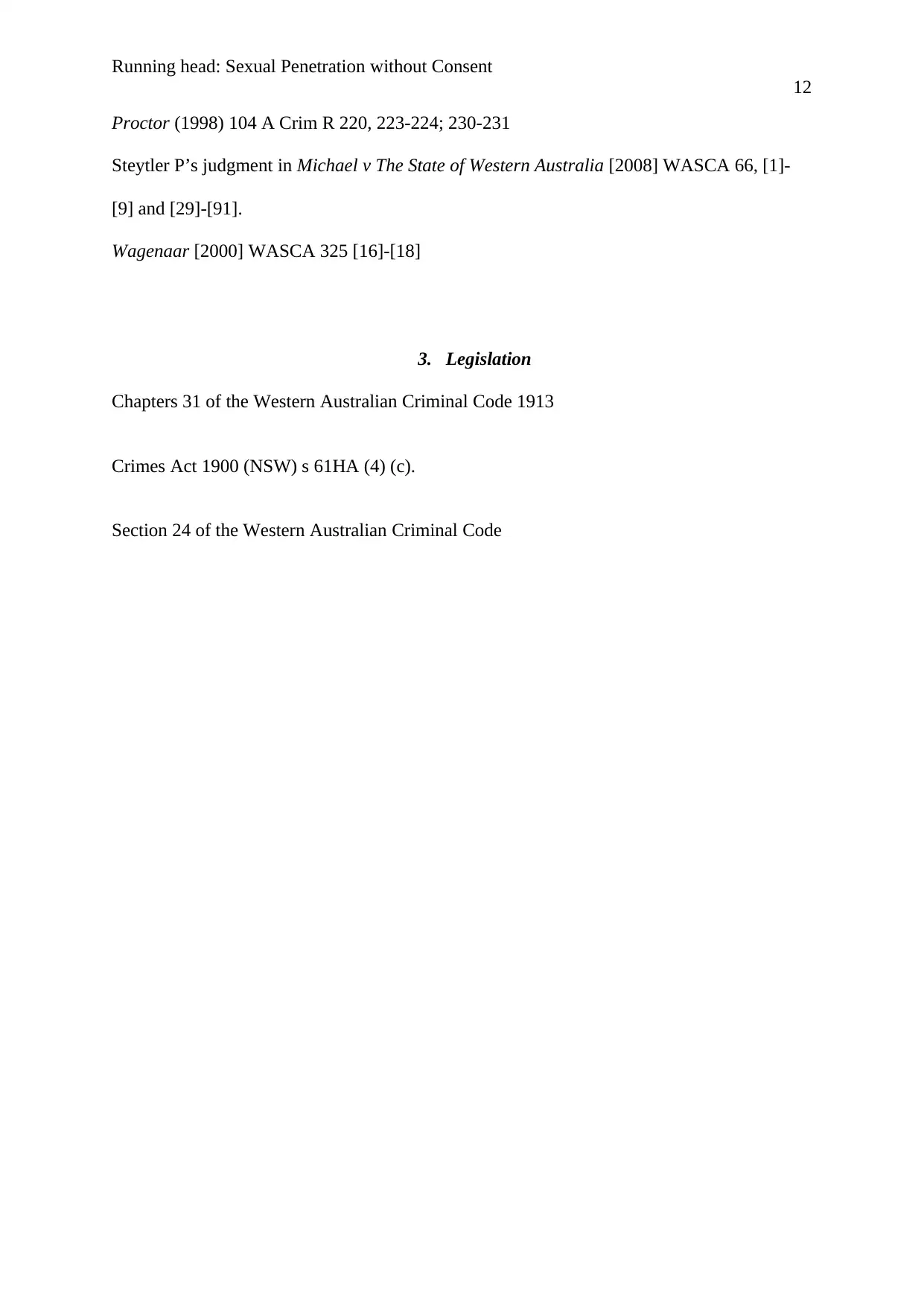
Running head: Sexual Penetration without Consent
12
Proctor (1998) 104 A Crim R 220, 223-224; 230-231
Steytler P’s judgment in Michael v The State of Western Australia [2008] WASCA 66, [1]-
[9] and [29]-[91].
Wagenaar [2000] WASCA 325 [16]-[18]
3. Legislation
Chapters 31 of the Western Australian Criminal Code 1913
Crimes Act 1900 (NSW) s 61HA (4) (c).
Section 24 of the Western Australian Criminal Code
12
Proctor (1998) 104 A Crim R 220, 223-224; 230-231
Steytler P’s judgment in Michael v The State of Western Australia [2008] WASCA 66, [1]-
[9] and [29]-[91].
Wagenaar [2000] WASCA 325 [16]-[18]
3. Legislation
Chapters 31 of the Western Australian Criminal Code 1913
Crimes Act 1900 (NSW) s 61HA (4) (c).
Section 24 of the Western Australian Criminal Code
⊘ This is a preview!⊘
Do you want full access?
Subscribe today to unlock all pages.

Trusted by 1+ million students worldwide
1 out of 12
Your All-in-One AI-Powered Toolkit for Academic Success.
+13062052269
info@desklib.com
Available 24*7 on WhatsApp / Email
![[object Object]](/_next/static/media/star-bottom.7253800d.svg)
Unlock your academic potential
Copyright © 2020–2025 A2Z Services. All Rights Reserved. Developed and managed by ZUCOL.

